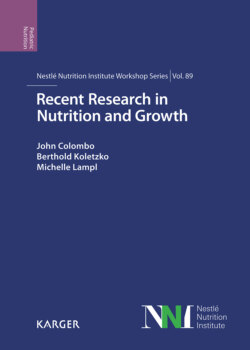Читать книгу Recent Research in Nutrition and Growth - Группа авторов - Страница 40
На сайте Литреса книга снята с продажи.
Mechanisms Driving Perinatal Muscle Hypertrophy
ОглавлениеThe acceleration in fiber hypertrophy in the perinatal period is the product of muscle protein accretion supported by the addition of myonuclei. Net protein deposition occurs when rates of protein synthesis are higher than degradation (Table 1). The primary factors that regulate protein synthesis are the maximum capacity for translation, which is determined by ribosomal abundance, and translational efficiency, which is dependent on the rate of translation initiation. In the immature muscle, protein synthesis is higher than at any other time in life and is the main driver of muscle protein accretion [12]. These high rates of protein synthesis, however, are manifested only in the fed state (Table 1) [17]. As muscle matures, postprandial protein synthesis rates diminish, and protein deposition falls in parallel. The concurrent decreases in postabsorptive synthesis rates and protein degradation are modest and make a small contribution to the developmental decline in protein deposition (Table 1). The high maximal capacity for protein synthesis is dictated by ribosomal abundance (reflected in total muscle RNA content). In the hind limb muscles of the newborn rat, values decrease by 70% from birth to maturity with minor changes in translational efficiency (Table 1).
The second property of the immature muscle is its ability to accelerate protein synthesis following a meal. The principal mediator of this response is the surge in plasma insulin and amino acids, particularly the branched-chain amino acid, leucine [12]. This rapid rise in insulin and amino acids independently stimulates translation initiation via the activation of the phosphoinositide 3-kinase/Akt-mechanistic target of rapamycin complex 1 (mTORC1) and the leucine-mTORC1 signaling pathways, respectively [12]. In contrast, when nutrients are delivered continuously, these signaling pathways and protein synthesis are muted as a result of low, constant levels of insulin and amino acids [18]. This response of the immature muscle to meal feeding emphasizes the importance of the postprandial surge in insulin and amino acids for eliciting the stimulation in protein synthesis during this anabolic window of muscle development. In more mature muscle, similar increases in plasma insulin and amino acids in response to a meal do not elicit the same magnitude of change in protein synthesis (Table 1). This capacity of the muscle to accelerate protein synthesis when nutrients are available channels amino acids towards anabolic processes so that they are not available for oxidation, and thereby promotes greater efficiency in the use of dietary amino acids for growth. Therefore, in the immature animal, feeding becomes a prime regulator of muscle growth. Moreover, as skeletal muscle is the largest and most rapidly expanding protein pool in the body at this time, it is a primary determinant of amino acid requirements.
The rapid hypertrophy of the myofibers also requires an increase in myonuclear abundance. Myonuclei, however, are postmitotic, and an increase in their numbers following fiber differentiation depends on the activity of a muscle progenitor cell population known as satellite cells that can both self-renew or terminally differentiate into myonuclei (Fig. 1). Their numbers are most abundant soon after myofibers form, and their proliferation and differentiation contribute to the rapid rise in myonuclei at this stage [19, 20]. As terminal maturation progresses, satellite cell numbers decrease, and they become quiescent with myonuclear accretion reaching a nadir at approximately 3 weeks of age in the hind limb muscle of mice [20] and within 2–4 months of age in human abdominal muscles [21]. Studies in which satellite cell-proliferative capacity was impaired through genetic manipulations also demonstrate an absolute requirement for satellite cell proliferation for fiber hypertrophy during the suckling period in mice [22]. During the third phase, there is little further addition of myonuclei, but continued protein deposition increases fiber hypertrophy and is manifested by the enlargement of myonuclear domain size.
Fig. 2. Responses of muscle protein mass per millimeter bone length (a), satellite cell numbers (b), and myonuclear abundance per fiber profile (c) in hind limb muscle of mice that had been undernourished from birth to 11 days (d) of age (EUN) or from 11 to 22 days of age (LUN), and after 22 days of nutritional rehabilitation. Values are expressed as percentages of age-matched controls, shown as 100 ± 2% SD (shaded area). n = 7–9 mice/group. ap < 0.05 vs. age-matched control; bp<0.05 vs. undernourished state. Data are from Fiorotto et al. [15] and unpublished data.
